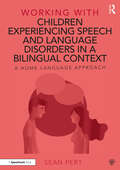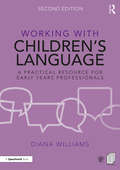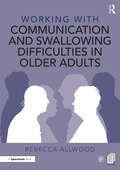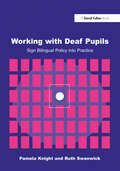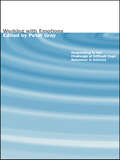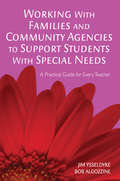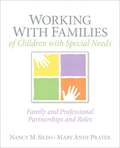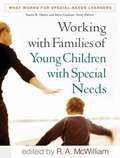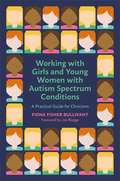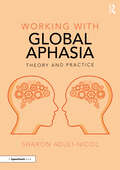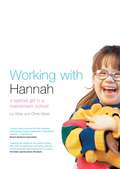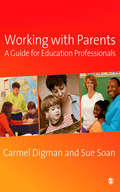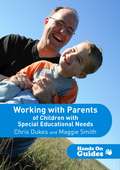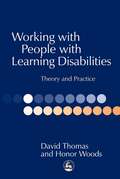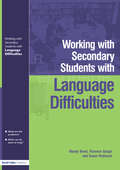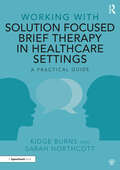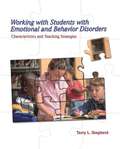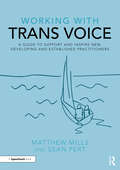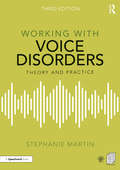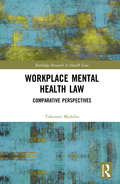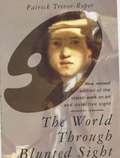- Table View
- List View
Working with Children Experiencing Speech and Language Disorders in a Bilingual Context: A Home Language Approach (Working With)
by Sean PertThe complexity of speech and language disorders can be daunting in a monolingual context. When working with a bilingual child assessment and intervention may appear to be even more complicated. In this book Sean Pert provides the reader with the tools needed to overcome this perception and develop skills in working in a language that they don’t share with the client. By adopting a home language first approach the book discusses how to: identify diversity from disorder introduce effective approaches in line with the best clinical practice work successfully alongside interpreters make assessments and plan interventions set goals for therapy. At the heart of the text is the therapist creating essential partnerships with parents and truly valuing the bilingualism, culture and identity of the child. This leads to better outcomes, not only in speech, language and communication, but also in self-esteem, mental health, social participation and educational and employment success. The book concludes with a handy toolkit of resources including quizzes, case studies and printable extras making it the perfect resource for both experienced and newly qualified practitioners with bilingual and multilingual children in their care.
Working with Children’s Language: A Practical Resource for Early Years Professionals (Working With)
by Diana WilliamsThis revised and updated second edition of Working with Children’s Language has been created to support practitioners who work with young children with delayed language acquisition. Rooted in a developmental theory of language learning, it covers topics such as attention control and listening, the role of play, verbal comprehension and the acquisition of spoken expressive language. Each chapter offers a straightforward overview of current research relating to the specific language skill before introducing a wealth of targeted games and activities that can help support the development of those skills. Key features include: • A structured approach to language learning that can be followed as a programme or adapted for informal use by individual practitioners. • Accessible activities, games and ideas suitable for small group or individual intervention, linked to specific aims based on developmental norms. • Photocopiable and downloadable resources, including a record sheet to track progress in each skill against aims and outcomes for individual children. Clearly linking theory and practice in an engaging and easy-to-follow format, this is an invaluable resource to support children in early years settings and Key Stage 1 whose language is delayed, but who are otherwise developing normally. It is a must-have book for early years practitioners, teachers, SEND professionals and speech and language therapists with varying levels of experience.
Working with Communication and Swallowing Difficulties in Older Adults (Working With)
by Rebecca AllwoodThis accessible resource offers valuable guidance for all student and practising speech and language therapists (SLTs)who are working with older people with communication and swallowing difficulties. Chapters provide up-to-date theory on age-related changes alongside practical strategies for clinicians to use in their daily work, from help with mental capacity decisions to supporting older people with good palliative care. Promoting a holistic approach for ageing well, this resource dispels myths that surround the ageing process while detailing the normal physiological and psychological effects of ageing on communication and swallowing, as well as diseases and conditions associated with older age, such as frailty. Illustrated throughout with clinical case studies and helpful photocopiable resources to use in practice, this book is a key part of the tool kit for any speech and language therapist working with older adults.
Working with Deaf Children: Sign Bilingual Policy into Practice
by Pamela Knight Ruth SwanwickThis book is essential and accessible reading for all teachers and professionals who are working with sign bilingual deaf children. It considers the background and theory underpinning current developments in sign bilingual education and the implications for policy and developing classroom practice. Practical teaching strategies are suggested and evaluated. The authors draw on their own experience of working in sign bilingual settings as well as current good practice and relevant research. This book is the first UK book that describes sign bilingual education (beyond policy). It is also the first book to support sign bilingual practice dealing with current educational issues. The authors draw together relevant research and practice in sign bilingual education and present practical strategies for teachers.
Working with Emotions: Responding to the Challenge of Difficult Pupil Behaviour in Schools
by Peter GrayDifficult pupil behaviour presents a number of issues for teachers, parents, other pupils as well as for children themselves. Inevitably it raises a number of emotions and challenges people's sense of their own personal effectiveness.This edited collection of short, concise chapters provides advice and guidance to professionals on how to respond to the emotions experienced and generated by pupils with behavioural difficulties in schools. Many chapters are written by such professionals themselves and address common problems in a practical and accessible way. Working with Emotions is an essential text for all schools, support services, LEAs, SENCOs and voluntary agencies and includes discussions on the government's current Social Inclusion initiative.
Working With Families and Community Agencies to Support Students With Special Needs: A Practical Guide for Every Teacher
by Dr James E. Ysseldyke Bob AlgozzineTeachers will find practical guidelines for collaborating with families, applying early childhood intervention, using transition services, involving community agencies and businesses, and identifying post-high school options.
Working With Families Of Children With Special Needs: Family And Professional Partnerships And Roles
by Nancy Sileo Mary PraterAn engaging discussion of the legal, ethical, practical, and cultural considerations of working with families of special needs children. With a strong focus on the families of special needs children, this first edition text provides students with both the information to understand the challenges and needs of these families as well as the skills and strategies required of educators working with such families. Containing a thorough discussion of the common legal and ethical concerns surrounding children with special needs and their families, this book also emphasizes the many individual differences among families. With that in mind, the authors focus on diversity in families with special needs children, cultural considerations, age, and communication with special needs families. In addition, a distinctive final chapter called “A Family’s Voice,” gives students the special opportunity to hear about the unique thoughts and experiences of a large selection of family members of children with special needs.
Working with Families of Young Children with Special Needs
by R. McwilliamThis user-friendly book presents research-based best practices for serving families of children with special needs from birth to age 6. Expert contributors demonstrate how early intervention and early childhood special education can effectively address a wide range of family concerns, which in turn optimizes children's development and learning. Tightly edited, the volume offers indispensable tools for assessing families; identifying and capitalizing on their strengths; providing information, support, and coaching; collaborating with parents and teachers to address children's functional needs in the context of everyday routines; and coordinating care. Over a dozen reproducible checklists and forms help professionals immediately implement the techniques and strategies described.
Working with Girls and Young Women with an Autism Spectrum Condition: A Practical Guide for Clinicians
by Fiona Fisher BullivantThis guide shows how clinicians can help girls and young women with ASC to reach their full potential, by adopting more relationship-based, individualised approaches. With contributions from young women about their experiences in clinical settings, the book reflects on what clinicians have done right and wrong to date, why girls and women with ASC are too often misunderstood, and how the culture of how clinicians work with them needs to change in order to achieve better results. In a concise and practical way, it covers how to better understand clients' needs and foster strong relationships through diagnosis, understanding comorbidities, sensory issues, self-harm, emotional regulation, assessments, interventions and strategies.
Working with Global Aphasia: Theory and Practice (Working With)
by Sharon Adjei-NicolGlobal aphasia is the most severe and disabling form of aphasia, yet it has had the least attention within aphasia research and rehabilitation. This practical book provides the reader with a comprehensive understanding of the topic based on both clinical observations and the literature to date. Uniquely, it covers not only the severe language impairments observed in global aphasia but also the co-occurring cognitive impairments that often present an additional challenge when working with this population. This book offers: • A comprehensive understanding of the clinical characteristics of global aphasia illustrated with real case examples • A theoretical overview of the domains of cognition and discussion of the role cognitive deficits play in the clinical presentation of people with global aphasia • Critical analysis of the research evidence on global aphasia • An exploration into the strengths and limitations of common methods used to assess language, cognition, and functional communication in global aphasia • New ways of approaching assessment and treatment which consider the impact of cognitive difficulties • Detailed suggestions of direct and indirect treatment tasks and approaches that can be used with this population, including novel cognitive tasks. This accessible text will provide both experienced speech and language therapists and students new to the subject with the knowledge, skills, and tools to work effectively with people with global aphasia in a range of clinical settings. It will also be an essential resource for anyone considering research with this challenging but highly rewarding population.
Working With Hannah: A Special Girl in a Mainstream School
by Chris Glass Liz WiseWorking with Hannah is a unique and detailed snapshot of the first years of schooling for a child with Down's Syndrome and severe mobility and communication problems. Written by two classroom assistants, who supported Hannah during her two and a half years in a mainstream infant school, this book shows how the right level of support can make inclusion a success not only for the child and family but also for the school itself. This practical guide describes the 'hands on' approach of Hannah's day-to-day management in a busy school. Topics covered include:*finding a school*how the school prepares*adapting the curriculum*recognising the importance of friendship*incorporating therapies into the school day*additional aspects of personal and, physical care*setting up communication systems.There are key points at the end of chapters, which highlight the salient aspects and offer practical advice.
Working with Parents: A Guide for Education Professionals
by Sue Soan Carmel Digman'This book would be excellent for anyone thinking of taking on the role of home/support worker or someone already in this post who would like to refresh their ideas and views. The book would also be of interest to those who want further insight into the complex role of the home/support worker' - Nasen's Special 'This book uses case studies across a range of ages to give practical advice on best practice when working with children and their parents in conjunction with other professionals....[T]he book contains much value to both class teachers and headteachers' - Headteacher Update 'This realistic and wide-ranging book supports the work of a growing number of school-based support staff' - Extended Schools Update 'This book helpfully covers the broad range of issues that home-school workers are likely to negotiate on a day to day basis. They give a realistic account of the challenges of working with parents from a school context, outlining a range of approaches, interventions, case studies and information to help practitioners provide effective support.' - Jo Hook, Transition Information Sessions (TIS) Consultant - Family and Parenting Institute With the opening of Children's Centres and the implementation of the Every Child Matters agenda, multi-agency working is now a reality. This book will provide advice and guidance on successful strategies to employ when working with parents and interdisciplinary staff. Using case studies to illustrate best practice across a range of age groups, the book looks at strategies for dealing with the effects of the following issues on children: o domestic violence o bereavement and loss o learning difficulties and special educational needs o neglect and poverty o anger and social, emotional and behavioural difficulties o addictions within the family. There is advice on working directly with children and examples are cited from children from 0 to 19. This book is an essential read for all those involved in the education and care of children.
Working with Parents of Children with Special Educational Needs (Hands on Guides)
by Maggie Smith Chris DukesIncludes CD-Rom `This very timely book...aims to support practitioners to work in partnership with parents, particularly those parents whose children have special or additional needs...It very clearly sets out the principles, legislative framework and processes which are essential knowledge for all SENCOs and managers in early years settings' - Early Years Update `The book has a positive approach to all aspects of working with parents and children...It's a book you can easily dip in and out of and is written in plain English...There aren't many textbooks I can read from cover to cover but this is one - I found it really interesting and enlightening. Score - 10 out of ten' - National Childminding Association `In short, this book provides almost everything you need in order to work successfully with parents' - Early Years Educator Are you looking for advice on how to work successfully with parents? Every practitioner knows that it is vitally important to work well with parents and make the relationship a positive and productive one, to ensure the best support for the child with special educational needs. This book offers clear strategies for ways to forge successful and lasting relationships with parents. It includes: - advice on working together with parents to improve the child's learning - strategies for communicating effectively with parents - help for the pre-school SENCO, showing how they can lead the process - tips for building successful links with other related professionals - activities and case studies - a CD Rom with checklists and useful photocopiable material. This book is ideal for all those working with the 0 to 5 age range, such as pre-school practitioners, nursery managers, advisory teachers, SENCOs, Inclusion Officers and Child Care and Education students and tutors. Chris Dukes and Maggie Smith are both Area SENCOs who work closely with pre-school SENCOs and Managers on a daily basis.
Working with People with Disabilities
by Richard PimentelGuide to working with the disabled in job placement and retention
Working with People with Learning Disabilities: Theory and Practice
by Honor Woods David ThomasA comprehensive introduction to working with people with learning disabilities, this guide provides the theoretical understanding needed to inform good practice and to help improve the quality of life of people within this group. Using accessible language and case examples, the authors discuss both psychological and practical theories, including: * person-centred and behavioural approaches * anti-discriminatory and anti-oppressive approaches * systems theory * task centred approach * role theory. Emphasising empowerment and inclusion of those with learning disabilities, they relate theory to issues such as loss and bereavement, sexuality and social stigma. They also provide guidance for practitioners on social policy and legislation and explore crisis intervention, values and ethics, advocacy and joint agency work, making this an extremely useful resource for social workers, nurses, teachers care workers and others working with people with learning disabilities.
Working with Secondary Students who have Language Difficulties
by Susan Robinson Mary Brent Florence GoughLanguage is the foundation of everything that goes on at school and is critical for formal learning and to interact socially. This book represents a whole school approach that includes tips for: identifying pupils with language learning difficulties following the book's simply explained guidelines; helping pupils overcome stumbling blocks by using the book's practical classroom strategies; modifying the schools curriculum to best support pupils with language learning difficulties; and timesaving resources in photocopiable format.
Working with Solution Focused Brief Therapy in Healthcare Settings: A Practical Guide (Working With)
by Kidge Burns Sarah NorthcottSolution focused brief therapy is an evidence-based approach that enables people to make meaningful change in their everyday lives. This book shares ideas on how speech and language therapists and others working in medical settings can integrate SFBT into their therapeutic interactions to support clients handling acute or chronic health conditions. It outlines core aspects of the approach in an accessible format, bridging the gap between theory and practice, and provides guidance on adapting SFBT for clients living with communication disabilities. There are suggestions for different clinical situations, with real-life case examples drawn from working with people living with Parkinson’s disease, stroke, motor neurone disease, cancer and chronic pain. Combining practical advice with photocopiable resources, this book covers: • Establishing person-centred, holistic goals for therapy • Future focused descriptions • Building on a person’s resources and successes • Responding to distress • Supervision and support This accessible book can be read as an introductory text for those new to this approach and will also be invaluable to clinicians who have already received some training in SFBT. It is likely to become a trusted resource, supporting allied health professionals and others to ensure their therapy is grounded in client priorities.
Working with Students with Emotional and Behavior Disorders: Characteristics and Teaching Strategies
by Terry L. ShepherdThe book is about children who have been identified as having emotional and behavior disorders, those who have not been identified, those who are depressed and suicidal, and those who display aggressive behavior in the classroom. This book is a practical guide combining theory, best practices, strategies, and interventions and is useful for beginning teachers, seasoned teachers, alternatively certified teachers, counselors, parents, and administrators.
Working with Trans Voice: A Guide to Support and Inspire New, Developing and Established Practitioners (Working With)
by Matthew Mills Sean PertThis book is an essential resource for those new to, developing and established in the field of trans voice. Presented in a workbook style and packed with practical exercises for the practitioner to engage with, it explores and explains how to work with clients effectively, while also developing vital cultural knowledge and fundamental skills in voice coaching that will help the practitioner develop insight into and support each person’s unique journey. Matthew Mills and Sean Pert draw on their wealth of experience to encourage the reader to consider what gender means to them, and how gender performance may be taken for granted by people whose gender identity aligns with their sex assigned at birth. The key learning points of this book are illustrated by guiding comments from trans and non-binary people with lived, practical and clinical experience Based on the latest expert practice and informed by the experiences of the clients themselves, Working with Trans Voice allows speech and language therapists and other professionals interested in supporting trans and gender-diverse people to develop the confidence to work with their clients in partnership and solidarity.
Working with Voice Disorders: Theory and Practice (Working With)
by Stephanie MartinNow in a fully revised and updated third edition, Working with Voice Disorders offers practical insight and direction into all aspects of voice disorders, from assessment and diagnosis to intervention and case management. Using evidence-based material, it provides clinicians with pragmatic, accessible support, facilitating and informing decision-making along the clinical journey, from referral to discharge. Key features of this resource include: A wealth of new, up-to-date practical and theoretical information, covering topics such as the prevention, assessment, intervention and treatment of a wide spectrum of voice disorders. A multi-dimensional structure, allowing the clinician to consider both specific aspects of patient management and aspects such as clinical effectiveness, clinical efficiencies and service management. Photocopiable clinical resources, from an at-a-glance summary of voice disorders to treatment and assessment protocols, and practical exercises and advice sheets for patients. Sample programmes for voice information groups and teacher workshops. Checklists for patients on topics such as the environmental and acoustic challenges of the workplace. Self-assessed personalised voice review sheets and weekly voice diaries encourage patients to monitor their voice quality and utilise strategies to prevent vocal misuse. Combining the successful format of mixing theory and practice, this edition offers a patient-centred approach to voice disorders in a fully accessible and easy-to-read format and addresses the challenges of service provision in a changing world. This is an essential resource for speech and language therapists of varying levels of experience, from student to specialist.
Workplace Mental Health Law: Comparative Perspectives (Routledge Research in Health Law)
by Takenori MishibaThis book provides a systematic and interdisciplinary study of occupational mental health legislation in seven countries. The work presents a study of the laws, policies, and legal interpretations to help prevent mental health problems from occurring in the workplace and appropriately address problems once they do occur. With a view to improving provision in Japan, the author examines the legal issues relating to workplace mental health and stress in the USA, UK, Denmark, the Netherlands, France and Germany. In presenting a comparative discussion of mental health issues in the workplace, this book seeks to establish a minimum for legal rights and duties that contribute to prevention and not just compensation. With its detailed comparative and descriptive coverage of legal and related provisions in a range of countries, the book will be a valuable resource for academics, policy-makers and practitioners working in labour and employment law, social welfare, occupational health and human resource management.
The World as I Have Found It
by Mary L. Day ArmsA graduate of the Maryland Institution for the Blind, Mary L. Day published a memoir in 1859 entitled Incidents in the Life of a Blind Girl. In this book, a sequel to her first, she recounts how she traveled throughout the country earning a living through the sale of her memoir. She also writes about meeting her future husband, visiting places of interest, and having numerous adventures on the road. The book closes with several essays on blindness and the education of the blind and with a collection of poems by blind authors.
The World At My Fingertips
by Karsten OhnstadKarsten Ohnstad shares his journey into blindness with warmth and humor.
The World in Flames: A Black Boyhood in a White Supremacist Doomsday Cult
by Jerald Walker<P>A memoir of growing up with blind, African-American parents in a segregated cult preaching the imminent end of the world. <P>When The World in Flames begins, in 1970, Jerry Walker is six years old. His consciousness revolves around being a member of a church whose beliefs he finds not only confusing but terrifying. Composed of a hodgepodge of requirements and restrictions (including a prohibition against doctors and hospitals), the underpinning tenet of Herbert W. Armstrong's Worldwide Church of God was that its members were divinely chosen and all others would soon perish in rivers of flames. <P>The substantial membership was ruled by fear, intimidation, and threats. Anyone who dared leave the church would endure hardship for the remainder of this life and eternal suffering in the next. The next life, according to Armstrong, would arrive in 1975, three years after the start of the Great Tribulation. Jerry would be eleven years old. <P>Jerry's parents were particularly vulnerable to the promise of relief from the world's hardships. When they joined the church, in 1960, they were living in a two-room apartment in a dangerous Chicago housing project with the first four of their seven children, and, most significantly, they both were blind, having lost their sight to childhood accidents. They took comfort in the belief that they had been chosen for a special afterlife, even if it meant following a religion with a white supremacist ideology and dutifully sending tithes to Armstrong, whose church boasted more than 100,000 members and more than $80 million in annual revenues at its height. <P>When the prophecy of the 1972 Great Tribulation does not materialize, Jerry is considerably less disappointed than relieved. When the 1975 end-time prophecy also fails, he finally begins to question his faith and imagine the possibility of choosing a destiny of his own.
The World Through Blunted Sight: An Inquiry into the Influence of Defective Vision on Art and Character
by Patrick Trevor-RoperA British ophthalmologist discusses his impressions of visually-impaired artists, including a number of the Impressionists.
